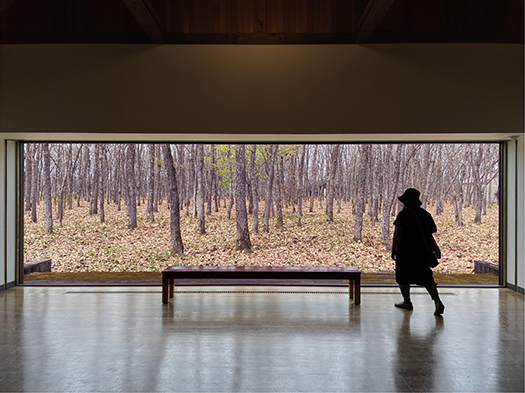
さて住宅とワンセットとして考えられる「庭」。本州地域の名建築的な住宅では、そのほとんどでいわゆる大名庭園的・数寄屋道楽みたいな和テイストの庭園がこれ見よがしに作庭されている。
そういった趣味生活領域はキライではなく、むしろ日本人としての心理のヒダに深く「刺さって」くる。けれども一方で、そのままでは、住宅建築本体では高断熱高気密が必須で積雪対策が庭環境としても絶対条件である北海道住宅では、ちょっと「そのままはムリ」と思ってブログテーマにしてみた。
で、きのうは司馬遼太郎記念館になっている作家の住宅と庭についてもご紹介した。
司馬氏は、あるがままの自然な雑木林のようなありように「数寄」を感じていたようだった。北海道人としては、ある種のシンパシーを感じていた次第。
そういった流れから、北海道人の庭、あるいは外部の景観との心理の「対話」ってどんなものかと考えて見て、ひとつの画像がこころに浮かんできた。それが上の写真。
北海道十勝の森の中の美術館からの「借景」硝子窓。
住宅サイズではないけれど、いわば心理的に北海道の大きな空、ゆたかな表情を見せてくれる自然と、生きるリズム感の部分で「同期」していると思われる。
わたしの個人的な心理の光景として、3歳の時から移転してきた札幌のわが家、それは札幌市中央区の北大植物園の西側立地で、窓からは鬱蒼とした植物園の森がある光景がこころにある。そして空を見上げると東北東方向には、ときにゆったりと、またときにはかなりのスピードでさまざまに表情を変えながら移動する「雲の光景」があった。
これは札幌からその方向に位置する石狩川河口からその流域に沸き立つ雲たちだった。雄大な石狩川が日本海に注ぎ流れていくときに海面との温度差から、その河川流域に沿って複雑な形状の雲を作って行く、その様子がなんとも不思議であり、そして自然が「生きている」と感じていた心理の起源だった。
庭というものが人間のこころと自然との「対話」環境創造であるとすれば、北海道の自然はそのように切り取って感受するというサイズをはるかに超えている。そして幼い頃のわたし同様に、それぞれの育った環境毎に、北海道の自然と心理同期する境界接点「窓」がそれぞれにあるのだと思う。
自分で家を建てたとき、敷地も選択したのだけれど実際に住んでみてから気付かされたのは、幼い頃と似たような、遠い石狩川流域との方角的位置関係と、家の前面にほかの家がないという視野環境の同一性だった。こじつけかも知れないけれど、この立地環境を選ぶとき、無意識の部分で「いいかも」という認識があったのかも知れないと思う。
わたしのデスク環境は、この石狩川が生み出す雲の表情を多少なりとも感受できる方角にある。青空なのにその方向にだけ沸き立ち、うごく雲を感じるとき、あるやすらぎがある。
English version⬇
Hokkaido people’s gardens are “borrowed landscapes,” a new “Kacho-fu-getsu” (flowers, birds, winds, and the moon).
A garden is a “dialogue” between the mind and nature to create an environment. There may be a difference in the way gardens are created with artistic intent and in areas where the size of nature is large to begin with. …
A “garden” is considered to be one set with a house. Most of the famous architectural houses in the Honshu area have Japanese-style gardens of the so-called “daimyo’s garden” or “sukiya-douraku” style.
I am not averse to such a hobbyist lifestyle, but rather, it “sticks” deeply in the folds of my Japanese psyche. On the other hand, however, I thought it would be a bit “impossible” to create such a garden in Hokkaido, where the house itself must be highly insulated and airtight, and where snow accumulation is an absolute requirement for the garden environment.
Yesterday, I also wrote about the house and garden of Ryotaro Shiba, the writer whose house is now part of the Ryotaro Shiba Memorial Museum.
Mr. Shiba seemed to feel “sukiyaki” in the natural wooded area as it is. As a Hokkaido native, I felt a certain sympathy for him.
This led me to wonder what kind of psychological “dialogue” Hokkaido people have with their gardens or external landscapes, and an image came to mind. That is the photo above.
It is a “borrowed view” glass window from a museum in a forest in Tokachi, Hokkaido.
Although not the size of a house, it seems to be psychologically “in sync” with the big sky of Hokkaido and the abundantly expressive nature, in terms of the sense of rhythm of life.
As a personal psychological scene, my home in Sapporo, where I have lived since I was three years old, is located on the west side of the Hokkaido University Botanical Garden in Chuo-ku, Sapporo City, and from the window I can see the dense forest of the garden. When I looked up at the sky, I saw a “cloud scene” moving in the east-northeast direction, sometimes slowly and sometimes quite quickly, changing its expression in various ways.
These were the clouds rising from the mouth of the Ishikari River, which is located in the direction from Sapporo, to the basin of the Ishikari River. When the majestic Ishikari River flows into the Sea of Japan, the temperature difference between the sea surface and the Ishikari River makes clouds of complex shapes along the river’s basin.
If a garden is an environmental creation of “dialogue” between the human mind and nature, then the nature of Hokkaido is far beyond the size of such a cutout to be perceived in this way. I believe that, like me as a child, each upbringing has its own boundary contact point or “window” to psychosynchronize with the nature of Hokkaido.
When I built my own house, I chose the site, but after actually living in the house, I realized that it was similar to my childhood in terms of the directional relationship with the distant Ishikari River basin, and that there were no other houses in front of the house, which made it an identical viewpoint environment. It may be a coincidence, but I think that when I chose this location, I may have had a subconscious awareness that it might be a good choice.
My desk is located in a direction that allows me to perceive the expression of the clouds created by the Ishikari River, even if only to a certain extent. When I feel the clouds rising and moving only in that direction in spite of the blue sky, I feel a certain peacefulness.
Posted on 5月 29th, 2024 by 三木 奎吾
Filed under: 住宅マーケティング







コメントを投稿
「※誹謗中傷や、悪意のある書き込み、営利目的などのコメントを防ぐために、投稿された全てのコメントは一時的に保留されますのでご了承ください。」
You must be logged in to post a comment.